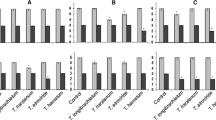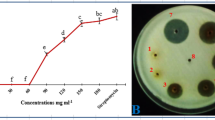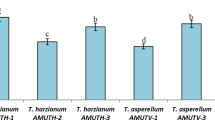Abstract
Botrytis cinerea is a common pathogenic agent, causing a significant reduction in tomato quality and yield. In this study, the potential of two biocontrol fungal agents, Trichoderma harzianum and Clonostachys rosea to prevent and alleviate B. cinerea infection was assessed. To this end, the fungicidal effects of both biocontrol fungi were evaluated on ten common phytopathogens, including B. cinerea. Then, various ratios of T. harzianum and C. rosea mixtures were assessed to find the ratio that best promotes the growth of tomato seedlings and prevents the establishment of B. cinerea. The results showed that T. harzianum and C. rosea had significant fungicidal effects on all tested phytopathogens. Also, both biocontrol agents reduced the establishment of B. cinerea, in vitro assays, indicating they had significant fungicidal effects against this phytopathogen. However, when applied as a biofungicide to tomato plants, a combination of both biocontrol agents gave better control of B. cinerea. Investigating the molecular basis of resistance to B. cinerea induced by the mixture of T. harzianum and C. rosea revealed that the salicylic acid signaling pathway plays an important role in modulating the antioxidant enzyme activity. Taken together, the results of this research confirmed that both biocontrol fungal agents could induce the mechanism of B. cinerea resistance in tomato plants and shed light on the regulatory pathways associated with the resistance mechanism.



Similar content being viewed by others
Data Availability
The data that support the findings of this study are available from the corresponding author upon reasonable request.
References
Alamri, S. A. (2014). The synergistic effect of two formulated biofungicides in the biocontrol of root and bottom rot of lettuce. Biocontrol Science, 19(4), 189–197. https://doi.org/10.4265/bio.19.189
Ambikapathy, V., Sengottaian, N., Shijila Rani, A. S., Babu, S., & Anbukumaran, A. (2023). Isolation of endophytic fungi from stems, leaves, or roots. In A. Sankaranarayanan, N. Amaresan, & M. K. Dwivedi (Eds.), Endophytic Microbes: Isolation, Identification, and Bioactive Potentials (pp. 27–29). New York: Springer, US. https://doi.org/10.1007/978-1-0716-2827-0_4
Anderson, I. C., Campbell, C. D., & Prosser, J. I. (2003). Potential bias of fungal 18S rDNA and internal transcribed spacer polymerase chain reaction primers for estimating fungal biodiversity in soil. Environmental Microbiology, 5(1), 36–47. https://doi.org/10.1046/j.1462-2920.2003.00383.x
Basu, S., Bose, C., Ojha, N., Das, N., Das, J., Pal, M., & Khurana, S. (2015). Evolution of bacterial and fungal growth media. Bioinformation, 11(4), 182–184. https://doi.org/10.6026/97320630011182
Bates, L. S., Waldren, R. P., & Teare, I. D. (1973). Rapid determination of free proline for water-stress studies. Plant and Soil, 39(1), 205–207. https://doi.org/10.1007/BF00018060
Burgess, J. G., Jordan, E. M., Bregu, M., Mearns-Spragg, A., & Boyd, K. G. (1999). Microbial antagonism: A neglected avenue of natural products research. Journal of Biotechnology, 70(1), 27–32. https://doi.org/10.1016/S0168-1656(99)00054-1
Cantu, D., Blanco-Ulate, B., Yang, L., Labavitch, J. M., Bennett, A. B., & Powell, A. L. T. (2009). Ripening-regulated susceptibility of tomato fruit to Botrytis cinerea requires NOR but not RIN or ethylene. Plant Physiology, 150(3), 1434–1449. https://doi.org/10.1104/pp.109.138701
Chan, Z., & Tian, S. (2006). Induction of H2O2-metabolizing enzymes and total protein synthesis by antagonistic yeast and salicylic acid in harvested sweet cherry fruit. Postharvest Biology and Technology, 39(3), 314–320. https://doi.org/10.1016/j.postharvbio.2005.10.009
Cheng, M., Meng, F., Mo, F., Qi, H., Wang, P., Chen, X., Liu, J., Ghanizadeh, H., Zhang, H., & Wang, A. (2022). Slym1 control the color etiolation of leaves by facilitating the decomposition of chlorophyll in tomato. Plant Science, 324, 111457. https://doi.org/10.1016/j.plantsci.2022.111457
Chiang, K. S., Liu, H. I., & Bock, C. H. (2017). A discussion on disease severity index values. Part I: warning on inherent errors and suggestions to maximise accuracy. Annals of Applied Biology, 171(2), 139–154. https://doi.org/10.1111/aab.12362
Conrath, U., Pieterse, C. M. J., & Mauch-Mani, B. (2002). Priming in plant–pathogen interactions. Trends in Plant Science, 7(5), 210–216. https://doi.org/10.1016/S1360-1385(02)02244-6
Cordier, C., Pozo, M. J., Barea, J. M., Gianinazzi, S., & Gianinazzi-Pearson, V. (1998). Cell defense responses qssociated with localized and systemic resistance to Phytophthora parasitica induced in tomato by an arbuscular mycorrhizal fungus. Molecular Plant-Microbe Interactions, 11(10), 1017–1028. https://doi.org/10.1094/MPMI.1998.11.10.1017
Cota, L. V., Maffia, L. A., & Mizubuti, E. S. G. (2008). Brazilian isolates of Clonostachys rosea: Colonization under different temperature and moisture conditions and temporal dynamics on strawberry leaves. Letters in Applied Microbiology, 46(3), 312–317. https://doi.org/10.1111/j.1472-765X.2007.02312.x
Cota, L. V., Maffia, L. A., Mizubuti, E. S. G., & Macedo, P. E. F. (2009). Biological control by Clonostachys rosea as a key component in the integrated management of strawberry gray mold. Biological Control, 50(3), 222–230. https://doi.org/10.1016/j.biocontrol.2009.04.017
De Meyer, G., Bigirimana, J., Elad, Y., & Höfte, M. (1998). Induced systemic resistance in Trichoderma harzianum T39 biocontrol of Botrytis cinerea. European Journal of Plant Pathology, 104(3), 279–286. https://doi.org/10.1023/A:1008628806616
Durrant, W. E., & Dong, X. (2004). Systemic acquired resistance. Annual Review of Phytopathology, 42(1), 185–209. https://doi.org/10.1146/annurev.phyto.42.040803.140421
El Komy, M. H., Saleh, A. A., Eranthodi, A., & Molan, Y. Y. (2015). Characterization of novel Trichoderma asperellum isolates to select effective biocontrol agents against tomato fusarium wilt. Plant Pathology Journal, 31(1), 50–60. https://doi.org/10.5423/ppj.Oa.09.2014.0087
Fiorini, L., Guglielminetti, L., Mariotti, L., Curadi, M., Picciarelli, P., Scartazza, A., Sarrocco, S., & Vannacci, G. (2016). Trichoderma harzianum T6776 modulates a complex metabolic network to stimulate tomato cv. Micro-Tom Growth. Plant and Soil, 400(1/2), 351–366.
Gardes, M., & Bruns, T. D. (1993). ITS primers with enhanced specificity for basidiomycetes - application to the identification of mycorrhizae and rusts. Molecular Ecology, 2(2), 113–118. https://doi.org/10.1111/j.1365-294X.1993.tb00005.x
Ghanizadeh, H., Mesarich, C. H., & Harrington, K. C. (2020). Molecular characteristics of the first case of haloxyfop-resistant Poa annua. Scientific Reports, 10(1), 4231. https://doi.org/10.1038/s41598-020-61104-0
Guillemaud, T., Blin, A., Le Goff, I., Desneux, N., Reyes, M., Tabone, E., Tsagkarakou, A., Niño, L., & Lombaert, E. (2015). The tomato borer, Tuta absoluta, invading the Mediterranean Basin, originates from a single introduction from Central Chile. Scientific Reports, 5(1), 8371. https://doi.org/10.1038/srep08371
Gullino, M. L., Aloi, C., & Garibaldi, A. (1991). Integrated control of grey mould of tomato. Integrated Control of Grey Mould of Tomato, 14(5), 211–215.
Han, Z., Ghanizadeh, H., Zhang, H., Li, X., Li, T., Wang, Q., Liu, J., & Wang, A. (2022). Clonostachys rosea promotes root growth in tomato by secreting auxin produced through the tryptamine pathway. Journal of Fungi, 8(11), 1166.
Hyun, J. W., Yi, S. H., MacKenzie, S. J., Timmer, L. W., Kim, K. S., Kang, S. K., Kwon, H. M., & Lim, H. C. (2009). Pathotypes and genetic relationship of worldwide collections of Elsinoë spp. causing scab diseases of citrus. Phytopathology, 99(6), 721–728. https://doi.org/10.1094/PHYTO-99-6-0721
Islam, M. T., & Sherif, S. M. (2020). RNAi-based biofungicides as a promising next-generation strategy for controlling devastating gray mold diseases. International Journal of Molecular Sciences, 21(6), 2072. https://doi.org/10.3390/ijms21062072
Jiang, C.-H., Liao, M.-J., Wang, H.-K., Zheng, M.-Z., Xu, J.-J., & Guo, J.-H. (2018). Bacillus velezensis, a potential and efficient biocontrol agent in control of pepper gray mold caused by Botrytis cinerea. Biological Control, 126, 147–157. https://doi.org/10.1016/j.biocontrol.2018.07.017
Kinkema, M., Fan, W., & Dong, X. (2000). Nuclear localization of NPR1 is required for activation of PR gene expression. The Plant Cell, 12(12), 2339–2350.
Krauss, U., ten Hoopen, M., Rees, R., Stirrup, T., Argyle, T., George, A., Arroyo, C., Corrales, E., & Casanoves, F. (2013). Mycoparasitism by Clonostachys byssicola and Clonostachys rosea on Trichoderma spp. from cocoa (Theobroma cacao) and implication for the design of mixed biocontrol agents. Biological Control, 67(3), 317–327. https://doi.org/10.1016/j.biocontrol.2013.09.011
Kunkel, B. N., & Brooks, D. M. (2002). Cross talk between signaling pathways in pathogen defense. Current Opinion in Plant Biology, 5(4), 325–331.
Latha, P., Anand, T., Prakasam, V., Jonathan, E. I., Paramathma, M., & Samiyappan, R. (2011). Combining Pseudomonas, Bacillus and Trichoderma strains with organic amendments and micronutrient to enhance suppression of collar and root rot disease in physic nut. Applied Soil Ecology, 49, 215–223. https://doi.org/10.1016/j.apsoil.2011.05.003
Li, X., Ghanizadeh, H., Han, Z., Li, T., Li, Y., Dou, Z., Qiu, Y., Chen, X., Zhang, Y., Liu, J., & Wang, A. (2023). Development and characterization of yeast-incorporated coating films for improving the postharvest shelf-life of snap beans. Postharvest Biology and Technology, 197, 112215. https://doi.org/10.1016/j.postharvbio.2022.112215
Liu, J., Wu, Y.-C., Kan, J., Wang, Y., & Jin, C.-H. (2013). Changes in reactive oxygen species production and antioxidant enzyme activity of Agaricus bisporus harvested at different stages of maturity. Journal of the Science of Food and Agriculture, 93(9), 2201–2206. https://doi.org/10.1002/jsfa.6027
Liu, J., Li, Z., Ghanizadeh, H., Kerckhoffs, H., Sofkova-Bobcheva, S., Wu, W., Wang, X., Liu, Y., Li, X., Zhao, H., Chen, X., Zhang, Y., & Wang, A. (2020). Comparative genomic and physiological analyses of a superoxide dismutase mimetic (SODm-123) for its ability to respond to oxidative stress in tomato plants. Journal of Agricultural and Food Chemistry, 68(47), 13608–13619. https://doi.org/10.1021/acs.jafc.0c04618
Luo, Y., Liang, J., Zeng, G., Chen, M., Mo, D., Li, G., & Zhang, D. (2018). Seed germination test for toxicity evaluation of compost: Its roles, problems and prospects. Waste Management, 71, 109–114.
Meng, F., Lv, R., Cheng, M., Mo, F., Zhang, N., Qi, H., Liu, J., Chen, X., Liu, Y., Ghanizadeh, H., & Wang, A. (2022). Insights into the molecular basis of biocontrol of Botrytis cinerea by Clonostachys rosea in tomato. Scientia Horticulturae, 291, 110547. https://doi.org/10.1016/j.scienta.2021.110547
Miao, S., Li, F., Han, Y., Yao, Z., Xu, Z., Chen, X., Liu, J., Zhang, Y., & Wang, A. (2022). Identification of OSCA gene family in Solanum habrochaites and its function analysis under stress. BMC Genomics, 23(1), 547. https://doi.org/10.1186/s12864-022-08675-6
Nawrocka, J., & Małolepsza, U. (2013). Diversity in plant systemic resistance induced by Trichoderma. Biological Control, 67(2), 149–156. https://doi.org/10.1016/j.biocontrol.2013.07.005
Nobre, S. A. M., Maffia, L. A., Mizubuti, E. S. G., Cota, L. V., & Dias, A. P. S. (2005). Selection of Clonostachys rosea isolates from Brazilian ecosystems effective in controlling Botrytis cinerea. Biological Control, 34(2), 132–143. https://doi.org/10.1016/j.biocontrol.2005.04.011
Otieno, W., Jeger, M., & Termorshuizen, A. (2003). Effect of infesting soil with Trichoderma harzianum and amendment with coffee pulp on survival of Armillaria. Biological Control, 26(3), 293–301. https://doi.org/10.1016/S1049-9644(02)00168-8
Peng, G., & Sutton, J. C. (1990). Biological methods to control grey mould of strawberry. Paper presented at the Brighton Crop Protection Conference, Pests and Diseases, Thornton Heath, Council Farnham.
Pieterse, C. M., & Van Loon, L. (2004). NPR1: The spider in the web of induced resistance signaling pathways. Current Opinion in Plant Biology, 7(4), 456–464.
Pieterse, C. M. J., Van Pelt, J. A., Van Wees, S. C. M., Ton, J., Léon-Kloosterziel, K. M., Keurentjes, J. J. B., Verhagen, B. W. M., Knoester, M., Van der Sluis, I., Bakker, P. A. H. M., & Van Loon, L. C. (2001). Rhizobacteria-mediated induced systemic resistance: Triggering, signalling and expression. European Journal of Plant Pathology, 107(1), 51–61. https://doi.org/10.1023/A:1008747926678
Radić, S., Radić-Stojković, M., & Pevalek-Kozlina, B. (2006). Influence of NaCl and mannitol on peroxidase activity and lipid peroxidation in Centaurea ragusina L. roots and shoots. Journal of Plant Physiology, 163(12), 1284–1292. https://doi.org/10.1016/j.jplph.2005.08.019
Saraiva, R. M., Czymmek, K. J., Borges, Á. V., Caires, N. P., & Maffia, L. A. (2015). Confocal microscopy study to understand Clonostachys rosea and Botrytis cinerea interactions in tomato plants. Biocontrol Science and Technology, 25(1), 56–71. https://doi.org/10.1080/09583157.2014.948382
Silva, P. R. A., Araujo, L., Resende, R. S., Maffia, L. A., Einhardt, A. M., Oliveira, H. R., Alves, Y. H., Silva, L. F., & Rodrigues, F. Á. (2020). Silicon, Clonostachys rosea, and their interaction for gray mold management in cucumber. Journal of Plant Pathology, 102(4), 1257–1262. https://doi.org/10.1007/s42161-020-00643-x
Sun, Z. B., Li, S. D., Ren, Q., Xu, J. L., Lu, X., & Sun, M. H. (2020). Biology and applications of Clonostachys rosea. Journal of Applied Microbiology, 129(3), 486–495. https://doi.org/10.1111/jam.14625
ten Hoopen, G. M., George, A., Martinez, A., Stirrup, T., Flood, J., & Krauss, U. (2010). Compatibility between Clonostachys isolates with a view to mixed inocula for biocontrol. Mycologia, 102(5), 1204–1215.
Tjamos, S. E., Flemetakis, E., Paplomatas, E. J., & Katinakis, P. (2005). Induction of resistance to Verticillium dahliae in Arabidopsis thaliana by the biocontrol agent K-165 and pathogenesis-related proteins gene expression. Molecular Plant-Microbe Interactions, 18(6), 555–561.
van Loon, L. C., Bakker, P. A. H. M., & Pieterse, C. M. J. (1998). Systemic resistance induced by rhizosphere bacteria. Annual Review of Phytopathology, 36(1), 453–483. https://doi.org/10.1146/annurev.phyto.36.1.453
Vlot, A. C., Dempsey, D. M. A., & Klessig, D. F. (2009). Salicylic acid, a multifaceted hormone to combat disease. Annual Review of Phytopathology, 47, 177–206.
Vukelić, I. D., Prokić, L. T., Racić, G. M., Pešić, M. B., Bojović, M. M., Sierka, E. M., Kalaji, H. M., & Panković, D. M. (2021). Effects of Trichoderma harzianum on photosynthetic characteristics and fruit quality of tomato plants. International Journal of Molecular Sciences, 22(13), 6961. https://doi.org/10.3390/ijms22136961
Wang, Y., & Liu, J.-H. (2012). Exogenous treatment with salicylic acid attenuates occurrence of citrus canker in susceptible navel orange (Citrus sinensis Osbeck). Journal of Plant Physiology, 169(12), 1143–1149.
Wang, Y., Yu, T., Xia, J., Yu, D., Wang, J., & Zheng, X. (2010). Biocontrol of postharvest gray mold of cherry tomatoes with the marine yeast Rhodosporidium paludigenum. Biological Control, 53(2), 178–182. https://doi.org/10.1016/j.biocontrol.2010.01.002
Wang, Q., Chen, X., Chai, X., Xue, D., Zheng, W., Shi, Y., & Wang, A. (2019). The involvement of jasmonic acid, ethylene, and salicylic acid in the signaling pathway of Clonostachys rosea-induced resistance to gray mold disease in tomato. Phytopathology, 109(7), 1102–1114.
Warcup, J. H. (1950). The soil-plate method for isolation of fungi from soil. Nature, 166(4211), 117–118. https://doi.org/10.1038/166117b0
Williamson, B., Tudzynski, B., Tudzynski, P., & Van Kan, J. A. L. (2007). Botrytis cinerea: The cause of grey mould disease. Molecular Plant Pathology, 8(5), 561–580. https://doi.org/10.1111/j.1364-3703.2007.00417.x
Xue, A. G. (2003). Biological Control of Pathogens Causing Root Rot Complex in Field Pea Using Clonostachys rosea Strain ACM941. Phytopathology®, 93(3), 329–335. https://doi.org/10.1094/PHYTO.2003.93.3.329
Yu, Q., & Rengel, Z. (1999). Drought and salinity differentially influence activities of superoxide dismutases in narrow-leafed lupins. Plant Science, 142(1), 1–11. https://doi.org/10.1016/S0168-9452(98)00246-5
Yu, X., Ai, C., Xin, L., & Zhou, G. (2011). The siderophore-producing bacterium, Bacillus subtilis CAS15, has a biocontrol effect on Fusarium wilt and promotes the growth of pepper. European Journal of Soil Biology, 47(2), 138–145. https://doi.org/10.1016/j.ejsobi.2010.11.001
Yuan, M., Huang, Y., Ge, W., Jia, Z., Song, S., Zhang, L., & Huang, Y. (2019). Involvement of jasmonic acid, ethylene and salicylic acid signaling pathways behind the systemic resistance induced by Trichoderma longibrachiatum H9 in cucumber. BMC Genomics, 20(1), 1–13.
Zehra, A., Meena, M., Dubey, M. K., Aamir, M., & Upadhyay, R. S. (2017). Synergistic effects of plant defense elicitors and Trichoderma harzianum on enhanced induction of antioxidant defense system in tomato against Fusarium wilt disease. Botanical Studies, 58(1), 44. https://doi.org/10.1186/s40529-017-0198-2
Zhang, L. B., & Feng, M. G. (2018). Antioxidant enzymes and their contributions to biological control potential of fungal insect pathogens. Applied Microbiology and Biotechnology, 102(12), 4995–5004. https://doi.org/10.1007/s00253-018-9033-2
Zhang, D., Yang, Y., Castlebury, L. A., & Cerniglia, C. E. (1996). A method for the large scale isolation of high transformation efficiency fungal genomic DNA. FEMS Microbiology Letters, 145(2), 261–265. https://doi.org/10.1111/j.1574-6968.1996.tb08587.x
Zhang, X., Francis, M. I., Dawson, W. O., Graham, J. H., Orbović, V., Triplett, E. W., & Mou, Z. (2010). Over-expression of the Arabidopsis NPR1 gene in citrus increases resistance to citrus canker. European Journal of Plant Pathology, 128(1), 91–100. https://doi.org/10.1007/s10658-010-9633-x
Zhang, F., Ge, H., Zhang, F., Guo, N., & Wang, Y. (2016). Biocontrol potential of Trichoderma harzianum isolate T-aloe against Sclerotinia sclerotiorum in soybean. Plant Physiology and Biochemistry, 100, 64–74. https://doi.org/10.1016/j.plaphy.2015.12.017
Zhao, Y., Thilmony, R., Bender, C. L., Schaller, A., He, S. Y., & Howe, G. A. (2003). Virulence systems of Pseudomonas syringae pv. tomato promote bacterial speck disease in tomato by targeting the jasmonate signaling pathway. The Plant Journal, 36(4), 485–499. https://doi.org/10.1046/j.1365-313X.2003.01895.x
Zhao, W., Zhou, X., Lei, H., Fan, J., Yang, R., Li, Z., Hu, C., Li, M., Zhao, F., & Wang, S. (2018). Transcriptional evidence for cross talk between JA and ET or SA during root-knot nematode invasion in tomato. Physiological Genomics, 50(3), 197–207.
Zheng, Y., Wang, X., Liu, S., Zhang, K., Cai, Z., Chen, X., Zhang, Y., Liu, J., & Wang, A. (2018). The endochitinase of clonostachys rosea expression in Bacillus amyloliquefaciens enhances the Botrytis cinerea resistance of tomato. International Journal of Molecular Sciences, 19(8), 2221.
Zubrod, J. P., Bundschuh, M., Arts, G., Brühl, C. A., Imfeld, G., Knäbel, A., Payraudeau, S., Rasmussen, J. J., Rohr, J., Scharmüller, A., Smalling, K., Stehle, S., Schulz, R., & Schäfer, R. B. (2019). Fungicides: An overlooked pesticide class? Environmental Science and Technology, 53(7), 3347–3365. https://doi.org/10.1021/acs.est.8b04392
Acknowledgements
This research was funded by the National Natural Science Foundation of China (31872120, 32072588), National Key R&D Program of China (2017YFE0105000), National High-Level Talents Special Support Program (W03020273) to A.W., the China Postdoctoral Science Foundation (2017M621235), the Postdoctoral Science Foundation of Heilongjiang Province (LBH-Z17034), and the "Young Talents" Project of Northeast Agricultural University (17QC26) to J.L.
Author information
Authors and Affiliations
Contributions
Fengshuo Li and Hossein Ghanizadeh: Writing- Reviewing and Editing; Wenwei Song: Picture and Software; Shuang Miao: Formal analysis; Hui Wang: Software; Xiuling Chen: Methodology; Jiayin Liu: Software, Validation, Aoxue Wang: Supervision.
Corresponding authors
Ethics declarations
Ethical approval
Ethics approval was not required for this research.
Conflict of interest
All the authors declare that there is no conflict of interest.
Supplementary Information
Rights and permissions
Springer Nature or its licensor (e.g. a society or other partner) holds exclusive rights to this article under a publishing agreement with the author(s) or other rightsholder(s); author self-archiving of the accepted manuscript version of this article is solely governed by the terms of such publishing agreement and applicable law.
About this article
Cite this article
Li, F., Ghanizadeh, H., Song, W. et al. Combined use of Trichoderma harzianum and Clonostachys rosea to manage Botrytis cinerea infection in tomato plants. Eur J Plant Pathol 167, 637–650 (2023). https://doi.org/10.1007/s10658-023-02732-w
Accepted:
Published:
Issue Date:
DOI: https://doi.org/10.1007/s10658-023-02732-w





